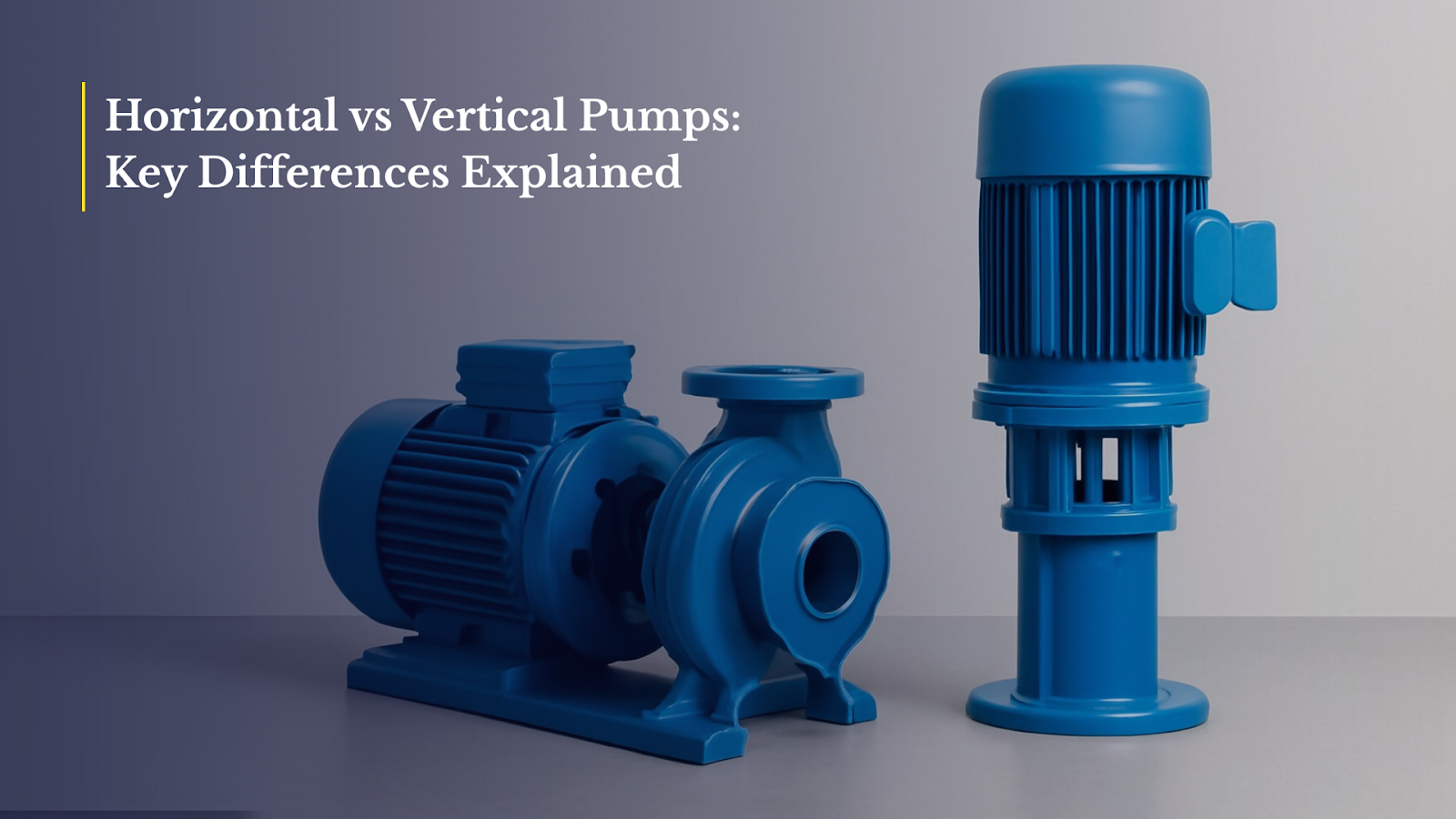In industries with heavy process fluid requirements, choosing the right pump is crucial for optimizing operational efficiency, reliability, and system performance. Key considerations include selecting a pump design that can handle various fluid types, manage energy consumption, minimize downtime, and comply with industry regulations.
For mid-to-large scale industries with complex fluid handling needs, the right pump choice directly impacts system performance and cost. Horizontal pumps are typically preferred for high-flow, low-head applications, where maintenance and accessibility are prioritized. In contrast, vertical pumps excel in high-head, low-flow applications, especially where space is limited and deep suction lift is necessary.
Key Takeaways:
- Horizontal pumps are best for high-flow, low-head applications, while vertical pumps excel in high-head, low-flow tasks.
- Horizontal pumps are more energy-efficient in high-flow, low-head applications; vertical pumps are more efficient in high-head, low-flow systems.
- Horizontal pumps require more floor space, whereas vertical pumps save space and are ideal for confined installations.
- Horizontal pumps are easier to maintain with better access to components, while vertical pumps are harder to service and may require specialized tools.
- Chemitek’s pumps are customizable to meet specific flow, head, and material requirements, providing tailored solutions for various industries.
Key Factors Influencing Pump Selection
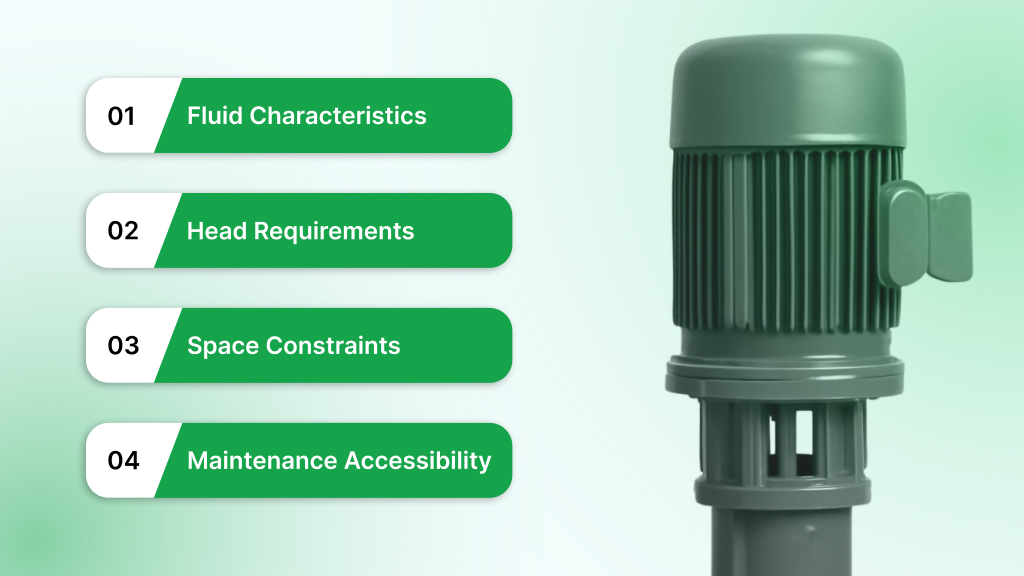
Before deciding between horizontal and vertical pumps, it’s crucial to assess several key elements that influence pump efficiency, performance, and overall operational costs. Below are the primary factors that should guide your selection process:
1. Fluid Characteristics
The nature of the fluid being pumped is one of the most critical factors in pump selection:
- Viscosity: Thick fluids (e.g., oils, syrups) require pumps with larger, stronger impellers to overcome increased resistance.
- Corrosiveness: Chemically aggressive fluids (e.g., acids, solvents) need pumps made from corrosion-resistant materials like stainless steel or alloys.
- Solids Presence: Fluids with solids or abrasives (e.g., slurry, waste water) require pumps with specialized impellers and liners to prevent clogging and wear.
2. Flow Rate and Head Requirements
The flow rate and head requirements dictate how the pump should be designed to handle the fluid.
- Flow Rate: The required flow rate, measured in cubic meters per hour (m³/h), determines how much fluid needs to be moved within a specific period. Systems that require high volumes of fluid to be moved at relatively low pressure will need pumps that can handle large amounts of fluid without causing excessive energy consumption.
- Head: Head refers to the height the fluid needs to be lifted or the pressure the pump must overcome. High-head systems require pumps that can generate enough pressure to push the fluid to the required height. Low-head systems, on the other hand, are typically designed to move fluids over short distances with less pressure but at higher flow rates.
3. Space Constraints
Available space for pump installation plays a critical role in selecting the appropriate pump type.
- Floor Space: The physical space available for the pump system will impact whether a compact or larger, more extended pump is required. In some cases, there may be limited space horizontally or vertically, which requires careful consideration of pump size and layout.
- Vertical vs. Horizontal Clearance: While some applications have limited horizontal space, they may offer ample vertical clearance. In other cases, systems with tight vertical space may need pumps designed to operate within those restrictions. Therefore, it's essential to assess the available space to ensure the pump can be installed without impacting other equipment or operations.
4. Maintenance Accessibility
Routine maintenance and repair accessibility are crucial factors to consider:
- Ease of Access: Pumps that are regularly maintained need to be easily accessible for inspections, repairs, and part replacements. Pumps with designs that allow easy access to critical components such as the impeller, seals, and bearings will reduce downtime and make routine maintenance more efficient.
- Servicing Needs: Some pump types are designed with features that facilitate maintenance, such as components that can be easily removed or replaced. Understanding how often the pump will need to be serviced and how easy it is to access critical parts will help determine the best option for long-term operational efficiency.
Having established the critical factors that influence pump selection, it's time to examine the two most common types of centrifugal pumps.
Overview of Horizontal and Vertical Centrifugal Pumps
Centrifugal pumps are essential equipment in many industrial sectors, offering efficient fluid transfer solutions. These pumps convert rotational energy from an electric motor into fluid energy using an impeller, and their designs can vary to suit different operational needs. Two common types of centrifugal pumps are horizontal and vertical centrifugal pumps.
1 Horizontal Centrifugal Pumps
Horizontal centrifugal pumps are widely used to transfer fluids by converting rotational energy from an electric motor into fluid energy via an impeller. The pump shaft is horizontally mounted, allowing fluid to enter and exit along the horizontal axis.
Horizontal centrifugal pumps are widely used in industries that require reliable, high-volume fluid transfer. Here are some typical applications:
- Water Treatment: For circulating water in treatment plants or moving large volumes of water in municipal systems.
- Chemical Processing: To move chemicals, acids, and solvents across production lines or in tank farms.
- Oil & Gas: Used for pumping crude oil or petroleum products through pipelines.
- Food & Beverage: In food processing systems, high volumes of liquid need to be transferred safely and efficiently.
- Power Generation: For cooling and other fluid management tasks in power plants.
2 Vertical Centrifugal Pumps
Vertical centrifugal pumps are designed to handle high-head, low-flow applications by using a vertically oriented shaft. The impeller, submerged in the fluid, is driven by the motor located above the fluid source.
These pumps are ideal for applications requiring deep suction lifts, such as deep-well pumping and sump drainage. Their compact vertical design saves floor space, making them perfect for installations with limited horizontal space.
Vertical centrifugal pumps are used in a variety of industries, particularly for applications requiring high suction lifts or vertical fluid movement. Common industries include:
- Water Treatment: Used in deep-well pumping, sump drainage, and effluent handling.
- Oil & Gas: For deep well injection and water lifting from reservoirs.
- Power Generation: In cooling systems for nuclear and fossil fuel plants.
- Chemical Processing: For moving high-pressure liquids in refining or chemical reactors.
- Mining: Used in slurry handling and dewatering applications.
- Municipal Applications: For water supply systems and sewage treatment.
- Food and Beverage: For handling liquids in food processing plants that need high-pressure fluid flow.
When choosing between horizontal and vertical pumps, several key differences come into play, including material selection, construction, cost-effectiveness, and operational performance.
Horizontal vs Vertical Pumps: A Comprehensive Comparison
In 2024, horizontal pumps made up approximately 60% of the global pump market, while vertical pumps accounted for around 40%. This distribution reflects their distinct applications and benefits.
While horizontal pumps dominate the market in volume, vertical pumps remain critical for specialized applications requiring high suction lift and vertical space efficiency.
1 Basic Concept: Horizontal vs Vertical Pumps
2. Pump Construction: Metallic vs Non-Metallic
Pumps are built from metallic or non-metallic materials depending on the chemical properties of the fluid, abrasiveness, temperature, and industry standards.
Metallic Pumps
- Materials Used: SS316, SS304, Duplex SS, Alloy 20, Hastelloy.
- Key Features:
- Excellent for corrosive, high-temperature, or abrasive fluids.
- Stronger structural integrity for high-pressure applications.
- Long life and durability in demanding industrial conditions.
Non-Metallic Pumps
- Materials Used: PP (Polypropylene), PVDF (Polyvinylidene Fluoride), PVC, ETFE, PTFE.
- Key Features:
- Chemically resistant to mild to moderately corrosive fluids.
- Cost-effective and lighter weight.
- Best for low to moderate pressure and ambient temperature applications.
- Not suitable for fluids with high temperatures or heavy abrasives.
3. Horizontal Centrifugal Pumps: Metallic vs Non-Metallic
4. Vertical Centrifugal Pumps: Metallic vs Non-Metallic
5. Choosing Between Metallic and Non-Metallic Pumps
The choice depends on chemical compatibility, temperature, pressure, abrasiveness, and budget.
6. Summary Decision Matrix
The mounting orientation of a pump significantly impacts its installation and space utilization. Let's now look at how horizontal and vertical pumps differ in this regard and how each suits various industrial setups.
Pump Types: Horizontal vs Vertical Mounting Options
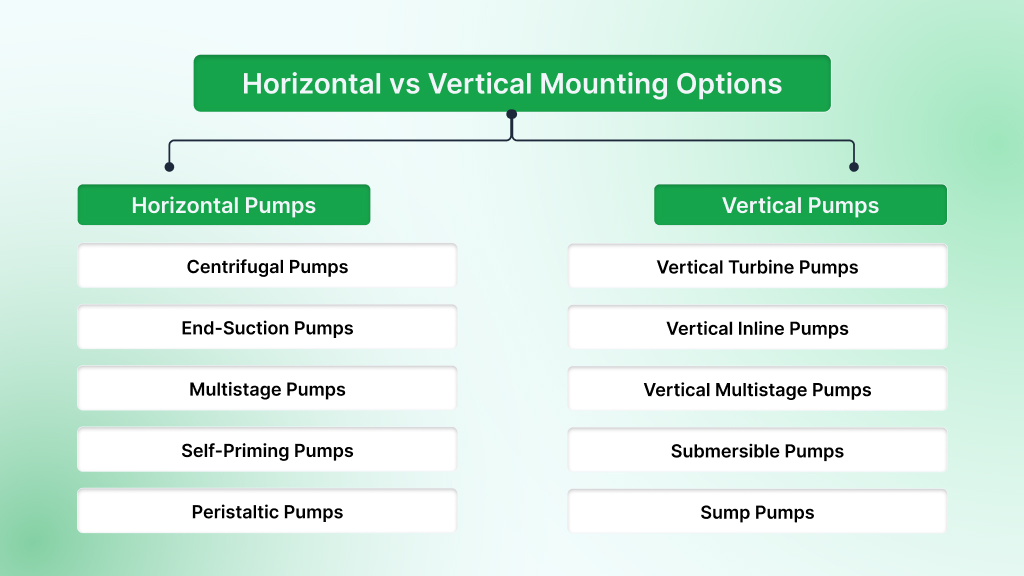
When selecting pumps for various industrial applications, it's essential to consider which types can be mounted horizontally or vertically. The mounting orientation affects not only the pump's efficiency but also its ease of installation, maintenance, and overall performance.
Pumps Typically Mounted Horizontally
- Centrifugal Pumps
- Application: Widely used for high-flow, low-head systems such as water treatment, chemical processing, and slurry handling.
- Features: Easy to install and maintain due to horizontal mounting; suitable for handling clean liquids, slurries, and chemicals. Horizontal centrifugal pumps are the most versatile in terms of installation and operational flexibility.
- End-Suction Pumps
- Application: Common in industries like HVAC, irrigation, and municipal water supply.
- Features: The inlet and outlet are located at opposite ends of the pump casing, providing a cost-effective and straightforward design. These pumps are widely used in industrial applications where space is not as limited, and they offer efficient fluid transfer.
- Multistage Pumps
- Application: Ideal for applications requiring higher pressure, such as boiler feed systems and water supply systems.
- Features: Multiple impellers in a series increase the pressure of the fluid. These pumps are mounted horizontally for easier alignment, maintenance, and operation, especially when multiple stages are required.
- Self-Priming Pumps
- Application: Used in wastewater treatment, sewage systems, and chemical processes.
- Features: These pumps can prime themselves and handle air or gases in the fluid. Typically mounted horizontally, they are used in applications where consistent flow is necessary despite varying fluid levels.
- Peristaltic Pumps
- Application: Often used for dosing chemicals, transferring viscous liquids, and handling slurries.
- Features: Known for their ability to pump thick or abrasive liquids. These pumps are mounted horizontally, providing easy access for maintenance and flexibility in installation.
Pumps Typically Mounted Vertically
- Vertical Turbine Pumps
- Application: Used for deep-well pumping in agriculture, mining, and oil extraction.
- Features: Designed for high-head, low-flow applications, vertical turbine pumps are excellent for lifting fluids from great depths. The motor is mounted above the fluid source, and the shaft extends downward to the impeller, making it ideal for deep-well and high-pressure systems.
- Vertical Inline Pumps
- Application: Common in HVAC systems, irrigation, and pressure boosting systems.
- Features: Compact design allows them to be mounted vertically for space-saving, making them ideal for areas with limited horizontal space. These pumps are also valuable for applications where high pressure and space efficiency are essential.
- Vertical Multistage Pumps
- Application: Used in high-pressure systems that need to lift fluids over considerable vertical distances, such as in high-rise buildings or industrial processes.
- Features: Similar to horizontal multistage pumps, but mounted vertically. They are ideal for applications where vertical space is available and a high head is required.
- Submersible Pumps
- Application: Common in wastewater treatment, sewage systems, and pumping from deep wells.
- Features: Fully submerged in the fluid being pumped, these pumps are mounted vertically for space efficiency and ease of installation. They handle a range of fluid types, including water, sewage, and chemical-laden liquids.
- Sump Pumps
- Application: Used in water drainage applications, such as removing water from basements or construction sites.
- Features: Designed to sit at the lowest point in a sump or pit, these pumps are mounted vertically to remove water or other fluids efficiently.
Understanding the differences in pump design is crucial, but the real challenge lies in selecting the right pump based on specific operational requirements.
Technical Considerations for Pump Selection
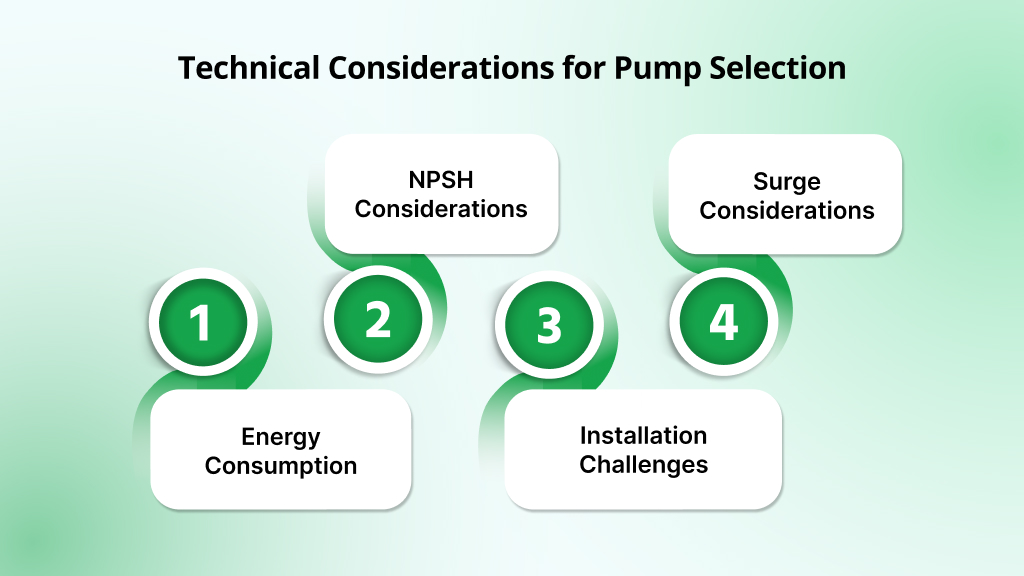
Key factors such as flow rate, head requirements, energy consumption, and maintenance accessibility directly influence the pump's operational cost and lifespan.
1. Pump Efficiency and Energy Consumption
Energy costs are a significant factor in operational costs for industrial systems. From a technical standpoint, horizontal pumps generally offer better energy efficiency for high-flow, low-head applications. Their design allows for better fluid velocity and reduced friction losses, which means they require less power for large volumes of fluid movement.
- Horizontal Pumping Efficiency: When handling fluids at low to moderate head, horizontal pumps maintain high volumetric efficiency, meaning less energy is wasted, and power consumption is optimized for high-flow operations.
- Vertical Pumping Efficiency: On the other hand, vertical pumps are designed to handle high-head applications but tend to operate at lower efficiency in low-flow conditions due to the higher friction losses in deep suction lifts. The higher pressure needed for lifting fluids can require more energy, particularly in intense systems.
Suggestion: If energy efficiency is a primary concern, horizontal pumps are a better choice for applications requiring high flow rates at moderate head, while vertical pumps are more suitable for high-head, low-flow systems where pressure lifting is critical, like deep-well pumping.
2. Net Positive Suction Head (NPSH) Considerations
Understanding the Net Positive Suction Head (NPSH) is crucial for both pump types to avoid cavitation, which can cause damage and reduce pump life. NPSH refers to the pressure available at the suction inlet to prevent cavitation.
- Horizontal Pumps: Generally, horizontal pumps perform well at moderate NPSH requirements. However, due to their relatively low suction capabilities, they can experience cavitation issues in applications that involve high-pressure variations or low suction head. In such cases, increasing the NPSH margin through appropriate system design (like using a larger suction diameter or reducing pipe length) becomes critical.
- Vertical Pumps: These pumps typically excel in maintaining a higher NPSH due to their submerged design, allowing them to draw fluids from deeper levels. As a result, they can handle deeper suction lifts without significant cavitation risks. This is particularly beneficial in applications involving high-pressure and low-flow systems.
Technical Insight: For systems with low NPSH or where cavitation risk is high, vertical pumps are preferred due to their better suction capabilities, especially in deep-well applications.
3. Installation Challenges: Space & Mounting Considerations
The physical and operational environment will significantly impact the choice between horizontal and vertical pumps. Here are some key points to consider from an installation perspective:
- Horizontal Pumps: These pumps typically require significant horizontal space, both for the pump itself and the associated motor. For large-scale installations, this could mean the need for specialized foundations, increasing both space and structural costs. Horizontal pumps also require precise alignment of the pump shaft and motor, which can affect efficiency and service life if not maintained properly.
- Suggestion: If you have a larger, open facility with sufficient horizontal clearance, horizontal pumps offer flexibility in terms of layout and are easier to align and mount. However, the larger footprint and need for specialized support can increase upfront installation costs.
- Vertical Pumps: These pumps require significantly less horizontal space, which is a significant advantage in installations where floor space is a premium (e.g., offshore platforms, multi-story buildings, or deep-well pumping). However, the vertical design requires careful alignment during installation, and specific systems might require reinforced mounting for larger pumps to support the vertical weight.
- Suggestion: If space is constrained in terms of horizontal area, vertical pumps are the go-to solution, especially in confined or multi-story environments. However, ensure the structure can support the pump's vertical load.
4. System Pressure and Surge Considerations
For systems that operate under variable pressures or require surge protection, understanding the impact of pump type on the overall system is vital.
- Horizontal Pumps: Horizontal pumps are generally better suited for systems with stable pressure profiles, where the fluid needs to be pumped at constant rates. They can handle pressure variations effectively but may require additional surge protection devices in systems with fluctuating flow rates.
- Vertical Pumps: Vertical pumps excel in high-pressure applications due to their ability to provide stable pressure over longer distances, particularly in deep-well or mining applications. However, these systems can be more prone to surge events, which may necessitate surge tanks or other pressure-regulating equipment.
Technical Insight: If your application involves large pressure surges or requires consistent pressure over long distances, vertical pumps are the better choice. Ensure that surge protection is considered when using horizontal pumps in fluctuating systems.
Choosing the right pump is crucial for maximizing system reliability and minimizing downtime. Chemitek’s horizontal pumps are top-tier solutions, delivering precision, durability, and energy efficiency for high-flow, low-head applications across demanding industries.
How Chemitek's Horizontal Pumps Meet Your Industrial Needs
Choosing the right pump is more than just a technical decision, it's a matter of ensuring efficiency, reliability, and longevity in your operations. Chemitek has become a trusted name in this space, offering metallic and non-metallic centrifugal pumps that meet the unique needs of a wide variety of industries.
Let's take a closer look at how these pumps can be the ideal solution for your business.
Why Chemitek Pumps Stand Out
Chemitek Process Equipment Pvt. Ltd., founded in 2009, has built a strong reputation for offering high-quality, energy-efficient, and reliable centrifugal pumps. Specializing in application engineering, Chemitek customizes its products to ensure they meet the exact needs of your operations.
1 Metallic Pumps: Built for Harsh Conditions
Chemitek's metallic centrifugal pumps are made from high-grade materials like SS316, SS304, Hastelloy, and Alloy 20, making them highly durable and capable of handling the most challenging fluids. These pumps are designed to operate efficiently even in harsh conditions, reducing frequent replacements and minimizing downtime.
2. Non-Metallic Pumps: Versatility Meets Cost-Effectiveness
For industries that deal with less aggressive fluids, Chemitek's non-metallic centrifugal pumps provide an excellent alternative. Made from materials such as PVC, PP, and PVDF, these pumps are perfect for applications involving clean liquids or mild chemicals. They offer reliable performance while being cost-effective and versatile, without sacrificing durability.
Why Chemitek Pumps Are a Trusted Choice
- Durability: Built for long-lasting performance, Chemitek pumps use investment cast components to enhance hydraulic efficiency and reliability in high-flow, high-pressure operations.
- Industry Compliance: Adhering to ANSI/ASME B73.1 standards, these pumps handle flows up to 1400 m³/hr and are ideal for demanding tasks, including slurry and corrosive media at high pressures and temperatures.
- Energy Efficiency: Designed for energy-efficient operation, Chemitek pumps reduce operating costs while maintaining consistent performance, even during peak production.
- Customizable Solutions: Chemitek pumps can be tailored to meet specific flow, head, and material needs, providing optimal performance for diverse industrial applications.
Conclusion
Selecting the right centrifugal pump is crucial for ensuring efficiency, reliability, and cost-effectiveness in industrial operations. Horizontal and vertical pumps each offer distinct advantages depending on the application. Horizontal pumps are best suited for high-flow, low-head tasks, while vertical pumps excel in high-head, low-flow applications. By considering factors such as fluid characteristics, space constraints, and energy efficiency, businesses can make a more informed decision that enhances their overall system performance.
For industries with complex fluid-handling needs, choosing the correct pump can optimize operations, reduce downtime, and lower long-term operational costs.
If you need customized solutions for high-flow, low-head or high-head, low-flow applications, contact us to discuss how our centrifugal pumps can meet your specific needs.
FAQs
1. What types of pumps are best for chemical processing?
For chemical processing, horizontal metallic centrifugal pumps made from corrosion-resistant materials such as SS316, Alloy 20, or Hastelloy are ideal. These pumps handle harsh chemicals while ensuring reliable, high-flow performance.
2. Which pump type is suitable for pharmaceutical applications?
In pharmaceutical manufacturing, horizontal pumps are typically favored for their easy maintenance and versatility. We recommend using non-metallic pumps for less aggressive fluids or metallic pumps for high-pressure, corrosive processes.
3. What is the best pump for deep-well applications in oil and gas?
For oil & gas, vertical centrifugal pumps are the optimal choice. Their compact design and high-head capabilities make them ideal for deep suction lifts, deep-well injection, and water lifting from reservoirs.
4. Which pumps are suitable for water and waste treatment?
Horizontal and vertical centrifugal pumps both play key roles in water treatment. Horizontal pumps are widely used for circulating water in treatment plants, while vertical pumps are ideal for deep-well pumping or sump drainage.
5. For power generation, what pump characteristics are necessary?
In power generation, pumps must handle high flow rates and corrosive or high-temperature fluids. Metallic horizontal pumps are the best fit for cooling and fluid management tasks, while vertical pumps are critical for deep suction lift applications.
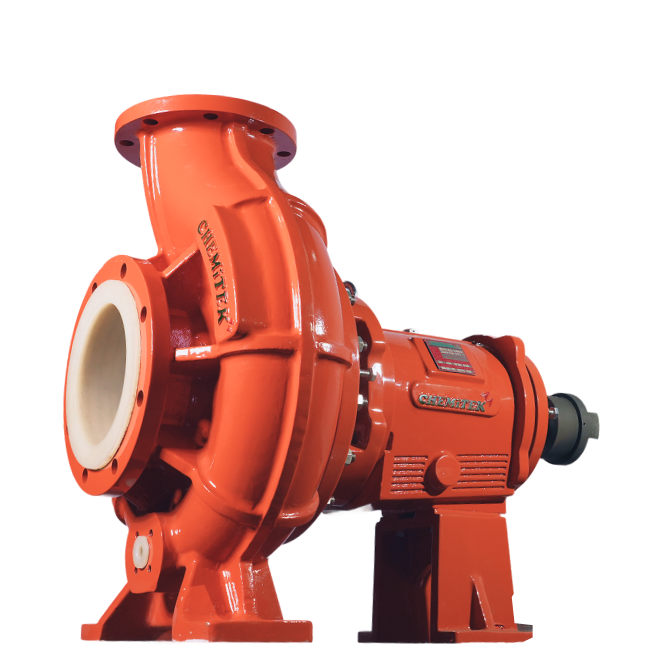
Latest posts
Ready to Upgrade Your Process Operations?
